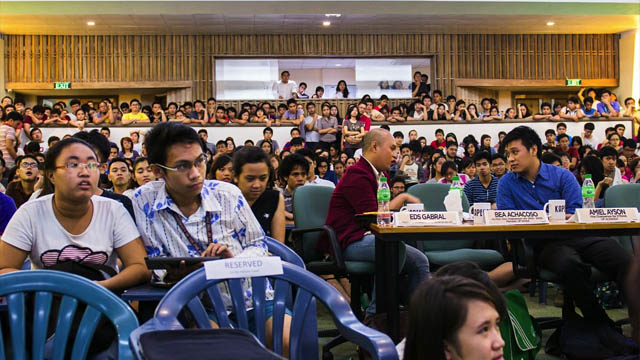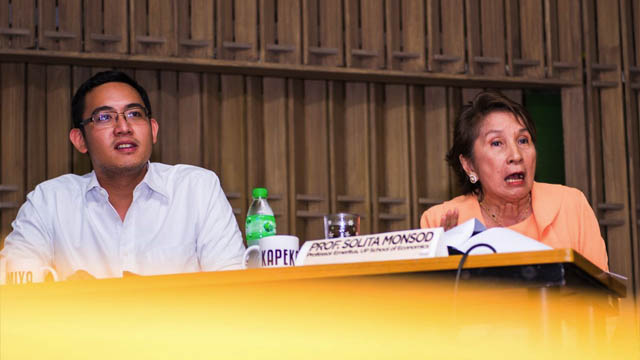SUMMARY
This is AI generated summarization, which may have errors. For context, always refer to the full article.

MANILA, Philippines – Prof Winnie Monsod, popularly known as “Mareng Winnie” on television, came to a forum on the controversial socialized tuition and financial assistance program (STFAP) of the University of the Philippines (UP), unaware that it was a debate. But among the speakers who argued for and against the controversial STFAP, she was the one in fighting form.
Monsod began by sharing the historical context of the STFAP: A product of almost a decade of discussions, it was introduced in the university recognizing the very highly unequal access to education in the country.
But since its implementation in 1989, STFAP has constantly been scrutinized by the university community due to various complaints. This year, UP is set to revise the STFAP.
READ: UP education: Burden of students or the state?
On Friday, July 12, UP professors and students debated whether it should be scrapped or reformed in a forum dubbed, “Surveying the Financial Affair Policy of UP.” Attended by more than 500 students, the forum was held at the School of Economics in Diliman campus as part of #Kapekonomiya, a series of semestral talks on issues organized by the UP Economics Towards Consciousness (UP-ETC) and the School of Economics Student Council (SESC).

‘UP education is a privilege’
Although she admitted that its implementation has been flawed, Monsod, a UPSE professor emeritus, called STFAP an “excellent concept,” arguing that it should be continued as it redistributes wealth.
Monsod said, “It’s helping the poorest of the poor, and making sure that the rich don’t get a free ride. They should not.”
The current STFAP follows an alphabetic bracketing scheme that includes the millionaires’ bracket A for those who can pay the full cost of education in UP and brackets E1 and E2 that offer free tuition and other benefits. Students assigned to other brackets (B,C, and D) enjoy a range of discounts.
“I have absolutely no sympathy for A, B and C. They should pay using their own money,” Monsod emphatically said.
“Are these the people you want to subsidize? Are you crazy?” Monsod added.
Monsod proposed a tuition hike for those under bracket A because they can afford the cost of UP education which is about P100,000 annually per student or about P3,000 per unit. At present, the maximum tuition is P1,500 per unit, which means at least 50% of the tuition of all UP students is subsidized.
“Education is a right, but education in UP is a privilege,” Monsod stressed.
.jpg)
Public good or commodity?
But any talk on increasing tuition does not sit well with students, particularly the militant ones. Unintimidated by the authoritative economics professor, Sarah Torres, chair of the student political party STAND-UP, insisted that even rich students in UP should be covered by STFAP.
“Kahit milyonaryo ka o mahirap, pantay-pantay dapat ang tuition. (Tuition should be the same for both millionaire or poor students). It’s the character of a public university,” Torres argued. Her main points included:
- That higher education itself is a good which should be provided to the people as an inherent right and not as a commodity for sale
- That higher education fulfills functions such as research, teaching, extension services and social criticism which do not further private gain but social welfare
Torres reminded the audience that STFAP was first promoted as a program that would democratize access to UP education. But according to her, it reduced UP education into a commodity “to be bought at full cost by those who can afford it.”
“STFAP is nothing but a cover-up, a smokescreen for tuition increase which, in turn, allows government to justify reducing its funding for state universities like UP,” Torres said.

Propaganda or solution?
But another student panelist, Juan Carlo Tejano of the Bukluran ng mga Progresibong Iskolar , dismissed Torres’ arguments as propaganda.
“Scrap STFAP now, and then what? Do not merely oppose, propose. Calling for its scrapping is mere propaganda. Calling for reform is an advocacy,” Tejano said in mixed English and Filipino.
Tejano enumerated a list of proposals that included institutional annual reviews of existing tuition policies and programs.
Meanwhile, Monsod suggested that the STFAP should be reviewed after every 3 years, noting that for 16 years — from 1989 to 2005 — the brackets were neither monitored nor modified even if prices had already increased thrice within the period.
But there’s another way to fix the problem — full state subsidy of UP education, according to Bea Achacoso, chairperson of the student government of National College of Public Administration and Governance (NCPAG).
The student leader pushed for the lobbying of a legislation called “Six Will Fix Bill” or the incremental increase of the education budget until it reaches 6% of the gross domestic product (GDP), the United Nations Educational, Scientific and Cultural Organization’s (UNESCO) target for the education sector.
Public expenditure on education in the country is way below the international standard – merely 2.45% of the GDP.
But Monsod only had this to say about attempts to demand 100% state subsidy: “In your dreams.”
READ: AS IT HAPPENS: Scrap or reform UP’s #STFAP? – Rappler.com
Add a comment
How does this make you feel?
There are no comments yet. Add your comment to start the conversation.